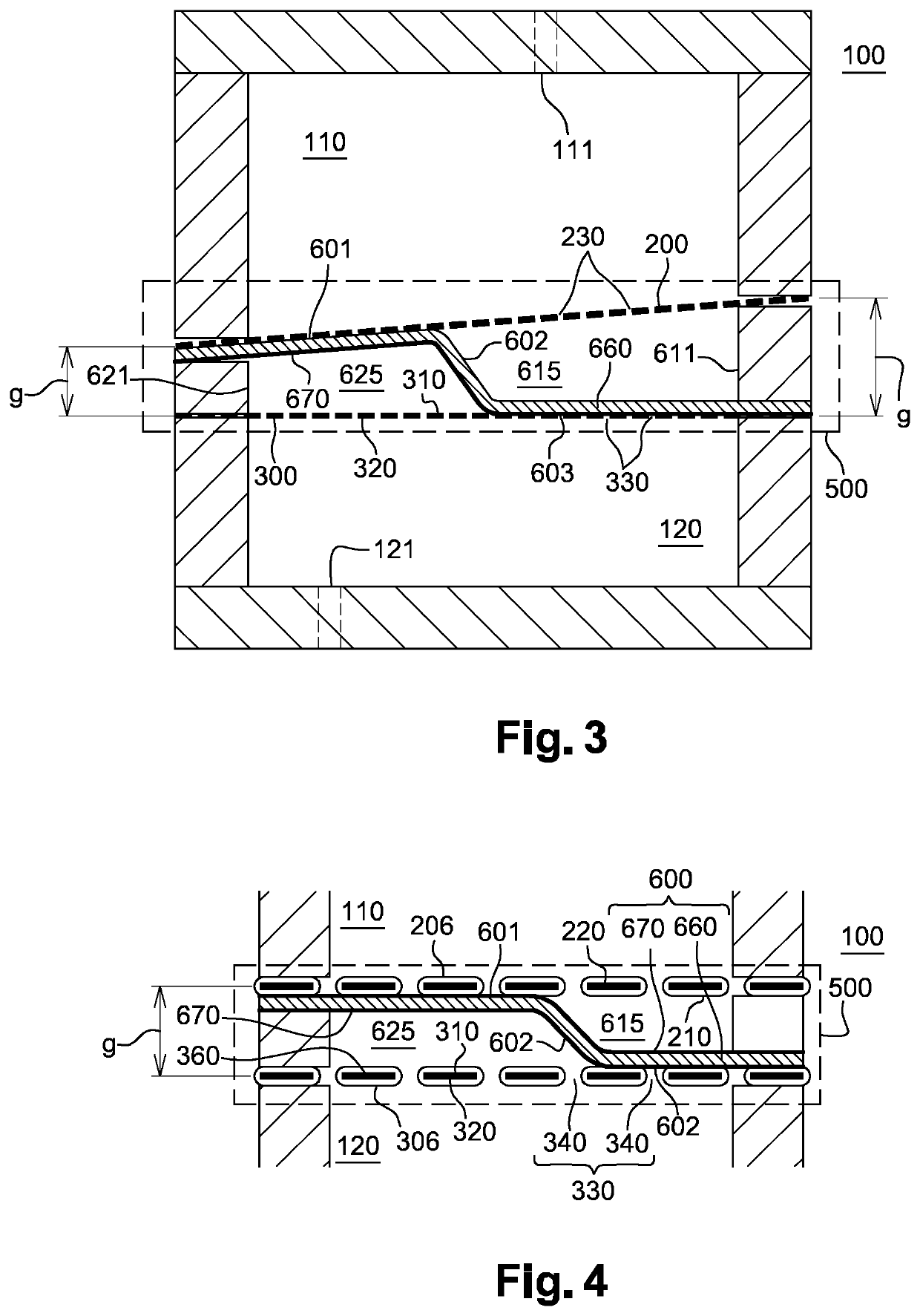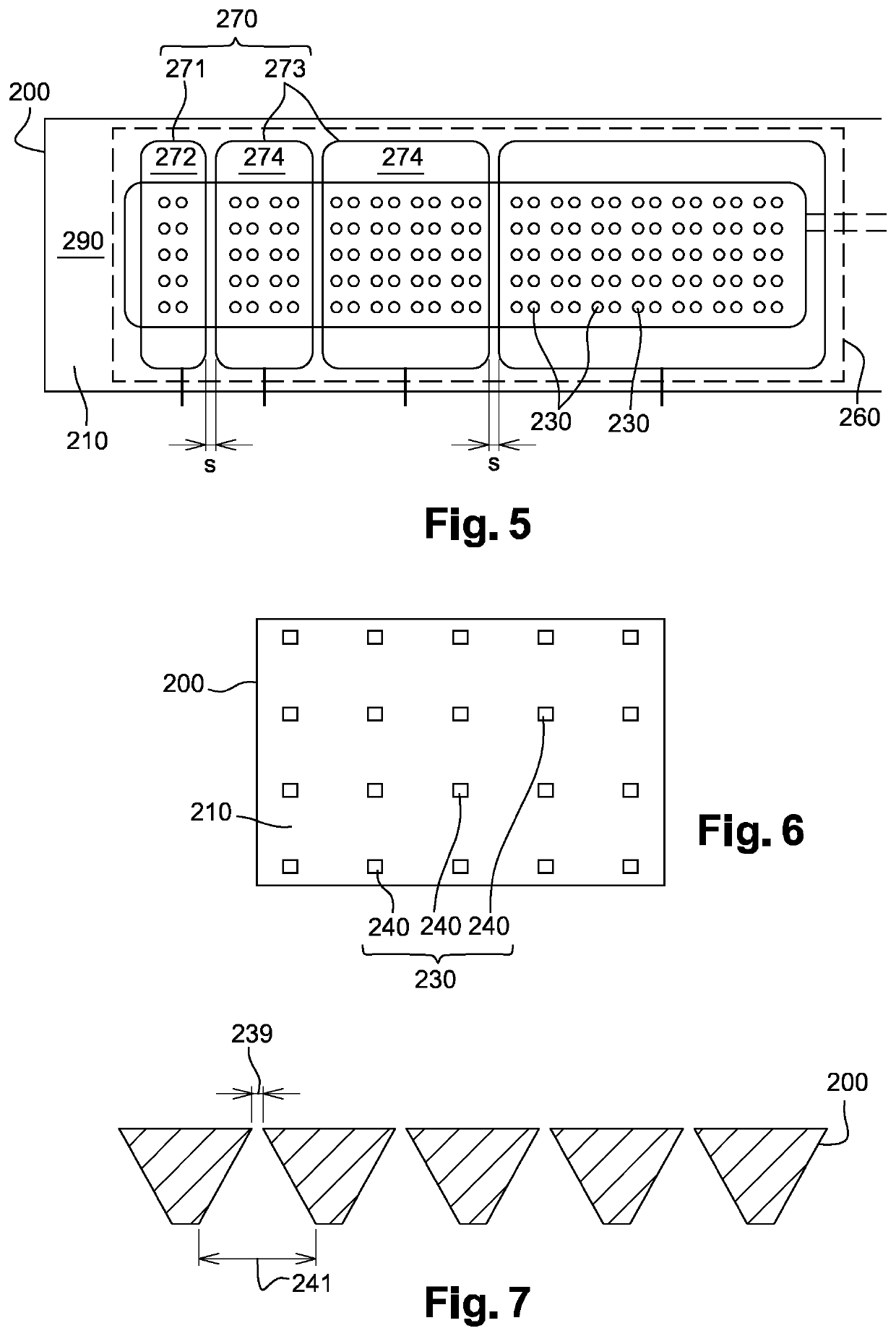Electrostatically actuated device
a technology of electro-actuation and actuator, which is applied in the direction of positive-displacement liquid engines, spectacles/goggles, instruments, etc., can solve the problems of low power efficiency and inability to adapt to the need of reversible pumping, and achieve the effect of reducing the capacity formed by the first deformable portion and the first primary surfa
- Summary
- Abstract
- Description
- Claims
- Application Information
AI Technical Summary
Benefits of technology
Problems solved by technology
Method used
Image
Examples
first embodiment
[0099] shown on FIG. 1, an electrostatically actuated device 100 configured to apply only a unidirectional force is disclosed. The electrostatically actuated device 100 comprises a first chamber 110. The first chamber 110 is configured to comprise a first fluid.
[0100]This first fluid may be configured to go through a first primary fluid passage 111, which means that the first fluid may have an engineered viscosity. This first primary fluid passage 111 may emerge outwardly, preferably outward of the first chamber 110. This first primary fluid passage 111 may be located on one side of the first chamber 110.
[0101]The first chamber 110 may be at least partially defined by a primary partition wall 200. This primary partition wall 200 may comprise a first primary surface 210, a second primary surface 220 and a plurality of second primary fluid passages 230. The second primary surface 220 may face the first chamber 110 and more precisely the second primary surface 220 may face the first pr...
third embodiment
[0116] shown on FIG. 3, the primary partition wall 200 and the secondary partition wall 300 may form a wedge or a slope such that the gap or wall distance g between the primary partition wall 200 and the secondary partition wall 300 may increases from one side of the electrode chamber 500 to the other. The gradient of thickness of the gap g insures a smooth transition of the electrostatically actuated device 100 with voltage as will be discussed later.
[0117]At least one of the partition walls among the primary partition wall 200 and the secondary partition wall 300, which may have a wall distance g smaller than 600 μm between them, and preferably smaller than 200 μm between them, may comprise a primary electroconducting pad. According to the embodiment shown on FIG. 3, the wall distance g between the primary partition wall 200 and the secondary partition wall 300 may vary such as to have a slope.
[0118]More precisely, the wall distance g between the primary partition wall 200 and the...
fourth embodiment
[0120] shown on FIG. 4, the primary partition wall 200 and the secondary partition wall 300 may be a part of the electrode by being connected to the higher voltage and to the lower voltage or vice versa and the PET deformable electrode 600 at the common reference or electrical ground. More precisely, there may be an primary electroconducting pad 270 on the first primary surface 210 and an secondary electroconducting pad on the first secondary surface 310 which is electrically connected to the higher voltage and to the lower voltage or vice versa and the PET deformable electrode 600 may comprise a deformable electroconducting layer 670 at the common reference or electrical ground.
[0121]In a particular embodiment wherein the deformable electroconducting layer 670 may be disposed on both side of the deformable electrode 600, the primary partition wall 200 and the secondary partition wall 300 will be insulated by an insulating layer 206 which can be deposit by at least of the method, bu...
PUM
| Property | Measurement | Unit |
|---|---|---|
| distance | aaaaa | aaaaa |
| wall distance | aaaaa | aaaaa |
| wall distance | aaaaa | aaaaa |
Abstract
Description
Claims
Application Information
 Login to View More
Login to View More - R&D
- Intellectual Property
- Life Sciences
- Materials
- Tech Scout
- Unparalleled Data Quality
- Higher Quality Content
- 60% Fewer Hallucinations
Browse by: Latest US Patents, China's latest patents, Technical Efficacy Thesaurus, Application Domain, Technology Topic, Popular Technical Reports.
© 2025 PatSnap. All rights reserved.Legal|Privacy policy|Modern Slavery Act Transparency Statement|Sitemap|About US| Contact US: help@patsnap.com



